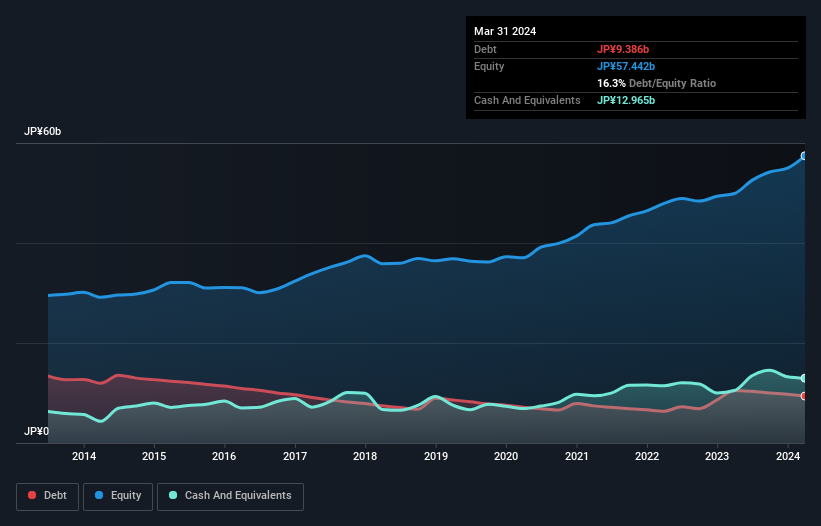These 4 Measures Indicate That Hodogaya Chemical (TSE:4112) Is Using Debt Reasonably Well

Some say volatility, rather than debt, is the best way to think about risk as an investor, but Warren Buffett famously said that 'Volatility is far from synonymous with risk.' When we think about how risky a company is, we always like to look at its use of debt, since debt overload can lead to ruin. As with many other companies Hodogaya Chemical Co., Ltd. (TSE:4112) makes use of debt. But should shareholders be worried about its use of debt?
When Is Debt A Problem?
Generally speaking, debt only becomes a real problem when a company can't easily pay it off, either by raising capital or with its own cash flow. If things get really bad, the lenders can take control of the business. While that is not too common, we often do see indebted companies permanently diluting shareholders because lenders force them to raise capital at a distressed price. Of course, plenty of companies use debt to fund growth, without any negative consequences. When we think about a company's use of debt, we first look at cash and debt together.
Check out our latest analysis for Hodogaya Chemical
What Is Hodogaya Chemical's Debt?
The image below, which you can click on for greater detail, shows that Hodogaya Chemical had debt of JP¥9.39b at the end of March 2024, a reduction from JP¥10.5b over a year. But on the other hand it also has JP¥13.0b in cash, leading to a JP¥3.58b net cash position.

How Healthy Is Hodogaya Chemical's Balance Sheet?
The latest balance sheet data shows that Hodogaya Chemical had liabilities of JP¥14.8b due within a year, and liabilities of JP¥8.95b falling due after that. Offsetting these obligations, it had cash of JP¥13.0b as well as receivables valued at JP¥12.2b due within 12 months. So it can boast JP¥1.50b more liquid assets than total liabilities.
This short term liquidity is a sign that Hodogaya Chemical could probably pay off its debt with ease, as its balance sheet is far from stretched. Succinctly put, Hodogaya Chemical boasts net cash, so it's fair to say it does not have a heavy debt load!
Fortunately, Hodogaya Chemical grew its EBIT by 6.8% in the last year, making that debt load look even more manageable. When analysing debt levels, the balance sheet is the obvious place to start. But it is future earnings, more than anything, that will determine Hodogaya Chemical's ability to maintain a healthy balance sheet going forward. So if you want to see what the professionals think, you might find this free report on analyst profit forecasts to be interesting.
Finally, a business needs free cash flow to pay off debt; accounting profits just don't cut it. While Hodogaya Chemical has net cash on its balance sheet, it's still worth taking a look at its ability to convert earnings before interest and tax (EBIT) to free cash flow, to help us understand how quickly it is building (or eroding) that cash balance. Looking at the most recent three years, Hodogaya Chemical recorded free cash flow of 38% of its EBIT, which is weaker than we'd expect. That weak cash conversion makes it more difficult to handle indebtedness.
Summing Up
While it is always sensible to investigate a company's debt, in this case Hodogaya Chemical has JP¥3.58b in net cash and a decent-looking balance sheet. On top of that, it increased its EBIT by 6.8% in the last twelve months. So we don't have any problem with Hodogaya Chemical's use of debt. Over time, share prices tend to follow earnings per share, so if you're interested in Hodogaya Chemical, you may well want to click here to check an interactive graph of its earnings per share history.
If you're interested in investing in businesses that can grow profits without the burden of debt, then check out this free list of growing businesses that have net cash on the balance sheet.
Valuation is complex, but we're here to simplify it.
Discover if Hodogaya Chemical might be undervalued or overvalued with our detailed analysis, featuring fair value estimates, potential risks, dividends, insider trades, and its financial condition.
Access Free AnalysisHave feedback on this article? Concerned about the content? Get in touch with us directly. Alternatively, email editorial-team (at) simplywallst.com.
This article by Simply Wall St is general in nature. We provide commentary based on historical data and analyst forecasts only using an unbiased methodology and our articles are not intended to be financial advice. It does not constitute a recommendation to buy or sell any stock, and does not take account of your objectives, or your financial situation. We aim to bring you long-term focused analysis driven by fundamental data. Note that our analysis may not factor in the latest price-sensitive company announcements or qualitative material. Simply Wall St has no position in any stocks mentioned.
About TSE:4112
Hodogaya Chemical
Primarily engages in the production and sale of organic industrial chemicals in Japan.
Flawless balance sheet, undervalued and pays a dividend.
Market Insights
Community Narratives



